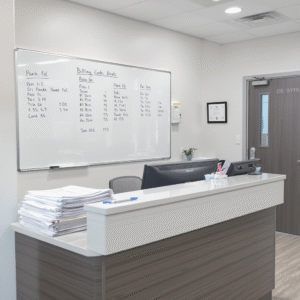Calculating Your Clean Claim Rate: A Key RCM Metric
Clean Claim Rate
Clean Claim Rate
In the complex world of healthcare revenue cycle management (RCM), few metrics are as critical to financial success as the clean claim rate. This fundamental performance indicator serves as a barometer for operational efficiency, directly impacting cash flow, administrative costs, and overall revenue optimization. Understanding how to calculate, monitor, and improve your clean claim rate can transform your healthcare organization’s financial performance.

What is a Clean Claim Rate?
A clean claim rate represents the percentage of medical claims submitted to insurance payers that are processed and paid without requiring any additional information, corrections, or resubmission. These claims pass through the initial adjudication process smoothly, containing all necessary information in the correct format with accurate coding and complete patient data.
The industry standard for an acceptable clean claim rate typically ranges from 85% to 95%, with top-performing organizations achieving rates above 95%. However, the benchmark can vary depending on the healthcare setting, payer mix, and specialty focus of the practice.
The Financial Impact of Clean Claims
The difference between a 90% and 95% clean claim rate might seem minimal, but the financial implications are substantial. Consider a practice that submits 1,000 claims monthly with an average reimbursement of $200 per claim. A 5% improvement in clean claim rate translates to 50 additional claims processed without delays or additional administrative work, representing $10,000 in accelerated cash flow each month.
Beyond immediate cash flow benefits, clean claims reduce administrative burden significantly. Each rejected or denied claim requires staff time to research, correct, and resubmit, often involving multiple touchpoints between billing staff, clinical teams, and payer representatives. This administrative overhead can cost healthcare organizations between $25 to $118 per reworked claim, according to industry studies.
Calculating Your Clean Claim Rate
The formula for calculating clean claim rate is straightforward:
Clean Claim Rate = (Number of Clean Claims ÷ Total Claims Submitted) × 100
However, the challenge lies in accurately defining what constitutes a “clean claim” and establishing consistent measurement periods. Organizations should track this metric monthly, quarterly, and annually to identify trends and seasonal variations.
Step-by-Step Calculation Process
- Define the measurement period: Establish whether you’re calculating monthly, quarterly, or annual rates.
- Count total claims submitted: Include all claims submitted to all payers during the defined period.
- Identify clean claims: Count claims that were accepted and processed for payment on the first submission without any rejections, denials, or requests for additional information.
- Apply the formula: Divide clean claims by total claims and multiply by 100 for the percentage.
- Segment the analysis: Calculate rates by payer, provider, service type, or department to identify specific improvement opportunities.

Factors Affecting Clean Claim Rates
Multiple variables influence clean claim rates, and understanding these factors is essential for targeted improvement initiatives.
Patient Registration and Demographics
Accurate patient information forms the foundation of clean claims. Common issues include incorrect insurance identification numbers, outdated coverage information, missing authorization numbers, and incomplete demographic data. Implementing robust patient registration processes and real-time eligibility verification can significantly reduce these errors.
Clinical Documentation Quality
Incomplete or inaccurate clinical documentation directly impacts coding accuracy and claim completeness. Physicians and clinical staff must provide detailed, specific documentation that supports the services rendered and diagnosis codes assigned. Regular training and documentation audits help maintain high standards.
Coding Accuracy and Compliance
Medical coding errors represent one of the most common causes of claim rejections. This includes incorrect procedure codes, mismatched diagnosis and procedure combinations, outdated code sets, and missing modifiers. Ongoing coder education and regular coding audits are essential for maintaining accuracy.
Technology and System Integration
Fragmented systems that don’t communicate effectively can introduce errors during data transfer. Modern practice management systems with integrated electronic health records (EHR) and robust claim scrubbing capabilities help identify potential issues before submission.
Strategies for Improving Clean Claim Rates
Front-End Revenue Cycle Optimization
The most effective approach to improving clean claim rates begins at the point of patient registration. Implementing comprehensive patient access procedures ensures accurate demographic information, insurance verification, and authorization obtainment before services are rendered.
Staff training plays a crucial role in front-end optimization. Registration personnel should be well-versed in insurance plan requirements, prior authorization processes, and patient responsibility calculation. Regular training updates keep staff current with changing payer requirements and industry best practices.
Denial Management
Investing in advanced revenue cycle management technology can dramatically improve clean claim rates. Real-time eligibility verification systems prevent coverage-related denials by confirming patient insurance status at the point of service. Automated claim scrubbing software identifies potential errors before submission, allowing for correction prior to payer review.
Integration between clinical and administrative systems reduces manual data entry and associated errors. When EHR systems seamlessly communicate with practice management platforms, the risk of transcription errors and data inconsistencies decreases significantly.

Ongoing Monitoring and Analysis
Establishing robust reporting mechanisms enables organizations to track clean claim rate trends and identify improvement opportunities. Regular analysis should include payer-specific performance, provider-level metrics, and service-type comparisons.
Monthly clean claim rate reports should be distributed to key stakeholders, including practice administrators, billing managers, and clinical leadership. These reports should highlight performance trends, identify problem areas, and track improvement initiative progress.

Industry Benchmarks and Best Practices
Leading healthcare organizations consistently achieve clean claim rates above 95% through disciplined processes and continuous improvement initiatives. These top performers share common characteristics including comprehensive staff training programs, robust technology infrastructure, regular process audits, and strong leadership commitment to revenue cycle excellence.
Specialty practices often face unique challenges that can impact clean claim rates. For example, surgical specialties may deal with complex authorization requirements, while mental health practices navigate specific documentation standards. Understanding specialty-specific benchmarks helps organizations set realistic improvement targets.
The Role of Denial Management
While the focus should be on preventing claim rejections through improved clean claim rates, effective denial management remains important for overall revenue cycle performance. Organizations should track denial rates alongside clean claim rates to gain a comprehensive view of claims processing effectiveness.
Common denial categories include eligibility issues, authorization problems, coding errors, and documentation deficiencies. Analyzing denial patterns helps identify root causes and inform process improvement initiatives that ultimately improve clean claim rates.
The Clean Claim Rate is a critical metric for several reasons:
- Cash Flow Management: Higher clean claim rates lead to faster reimbursements, improving cash flow for healthcare providers.
- Operational Efficiency: Clean claims require less manual intervention and rework, reducing administrative burden and costs.
- Revenue Optimization: By minimizing claim denials and rejections, providers can maximize their revenue potential.
- Performance Indicator: CCR serves as a key indicator of the overall health of a provider’s revenue cycle management processes.
- Resource Allocation: A high clean claim rate allows organizations to allocate resources more effectively, focusing on patient care rather than administrative tasks.
Multiple factors can impact an organization’s Clean Claim Rate:
Staff Training and Expertise
- Knowledge of coding guidelines
- Understanding of payer requirements
- Familiarity with compliance regulations
Documentation Quality
- Accuracy and completeness of clinical documentation
- Proper capture of patient information
- Timely documentation submission
Technology Infrastructure
- Quality of practice management software
- Integration between EHR and billing systems
- Automated claim scrubbing capabilities
Payer Relationships
- Understanding of specific payer requirements
- Communication channels with payers
- Contract management effectiveness
Internal Processes
- Pre-registration and eligibility verification
- Charge capture procedures
- Quality control measures
Calculating Clean Claim Rate
The Clean Claim Rate is calculated by dividing the number of claims paid on first submission by the total number of claims submitted, then multiplying by 100 to get a percentage. For example, if a practice submits 1,000 claims in a month and 850 are paid on the first submission, their clean claim rate would be 85%.
It’s important to note that some organizations may use variations of this calculation, such as:
- Excluding certain types of claims
- Measuring over different time periods
- Considering claims that require minimal corrections as “clean”
Industry Benchmarks
Clean Claim Rates can vary significantly across different healthcare settings and specialties.
However, general industry benchmarks include:
- Excellent: 95% or higher
- Good: 85-94%
- Average: 75-84%
- Poor: Below 75%
Factors affecting benchmark variations include specialty type, patient population, payer mix, geographic location, and practice size.
Common Challenges in Maintaining High Clean Claim Rates
Healthcare providers face numerous challenges in achieving and maintaining high clean claim rates:
Changing Regulations
- Frequent updates to coding guidelines
- New compliance requirements
- Shifting payer policies
Staff Turnover
- Loss of institutional knowledge
- Training requirements for new staff
- Consistency in processes
Technology Limitations
- Outdated software systems
- Poor integration between platforms
- Insufficient automation
Documentation Issues
- Incomplete clinical documentation
- Delayed charge capture
- Inconsistent documentation practices
Patient Information Accuracy
- Incorrect or outdated insurance information
- Demographic errors
- Missing authorizations
Strategies to Improve Clean Claim Rate
Implementing effective strategies can significantly improve clean claim rates:
Implement Robust Front-End Processes
- Verify insurance eligibility before service
- Collect accurate patient information
- Obtain necessary pre-authorizations
Invest in Staff Training
- Regular coding updates and education
- Payer-specific requirement training
- Best practices workshops
Utilize Technology Solutions
- Automated claim scrubbing
- Real-time eligibility verification
- Analytics for identifying trends and issues
Establish Quality Control Measures
- Regular audits of claim submissions
- Peer review processes
- Performance tracking and feedback
Optimize Workflow
- Standardized processes for claim submission
- Clear communication channels
- Defined roles and responsibilities
Technology and Tools
Modern healthcare organizations rely on various technologies to optimize their clean claim rates:
Practice Management Systems
- Automated claim generation
- Built-in claim scrubbing
- Reporting and analytics
Clearinghouse Services
- Additional claim scrubbing
- Real-time claim status
- Payer-specific edits
Revenue Cycle Management Software
- End-to-end claim tracking
- Denial management
- Performance analytics
Artificial Intelligence and Machine Learning
- Predictive analytics for potential denials
- Automated coding assistance
- Pattern recognition for common errors
Impact on Healthcare Providers
The effects of clean claim rates extend beyond simple financial metrics:
Financial Impact
- Improved cash flow
- Reduced administrative costs
- Higher net revenue
Operational Impact
- Streamlined workflows
- Better resource allocation
- Improved staff satisfaction
Patient Experience Impact
- Fewer billing-related patient complaints
- More time for patient care
- Enhanced overall satisfaction
Best Practices for Clean Claims
Following industry best practices can help maintain high clean claim rates:
Standardize Processes
- Develop clear protocols for claim submission
- Create checklists for common procedures
- Implement consistent quality control measures
Leverage Technology
- Use automated eligibility verification
- Implement claim scrubbing software
- Utilize analytics for continuous improvement
Focus on Documentation
- Ensure complete and accurate clinical documentation
- Implement concurrent coding when possible
- Regular documentation audits
Maintain Updated Information
- Regular updates to charge masters
- Current payer contracts and requirements
- Up-to-date patient information
Continuous Education
- Regular staff training
- Updates on coding changes
- Sharing of best practices
Future Trends
The landscape of clean claim management continues to evolve:
Artificial Intelligence Integration
- Predictive analytics for potential claim issues
- Automated coding assistance
- Real-time claim optimization
Blockchain Technology
- Enhanced security for claim submission
- Improved transparency in the billing process
- Streamlined payer-provider communication
Increased Automation
- Further reduction in manual processes
- Real-time claim adjustments
- Automated denial management
Enhanced Interoperability
- Better integration between systems
- Improved data sharing
- Standardized communication protocols
Conclusion
Clean claim rate serves as a fundamental metric for healthcare revenue cycle management, directly impacting cash flow, operational efficiency, and financial performance. Organizations that prioritize clean claim rate improvement through comprehensive front-end processes, technology investment, and ongoing monitoring achieve superior financial results while reducing administrative burden.
The path to achieving and maintaining high clean claim rates requires sustained effort across multiple organizational functions. From patient registration through claim submission, each step in the revenue cycle contributes to overall performance. By focusing on accuracy, consistency, and continuous improvement, healthcare organizations can optimize their clean claim rates and strengthen their financial foundation.
Regular measurement, analysis, and improvement of clean claim rates should be central to any healthcare organization’s revenue cycle management strategy. The investment in people, processes, and technology necessary to achieve high clean claim rates pays dividends through improved cash flow, reduced administrative costs, and enhanced organizational efficiency. In today’s challenging healthcare financial environment, organizations cannot afford to overlook this critical performance metric.



